Leading the Digital Transformation With Innoslate
Not up for the read? Sit back, relax, and watch the webinar recording! Organizations today are increasingly recognizing the need for digital...
8 min read
SPEC Innovations Team
:
4/3/24 3:35 PM
.png)
SPEC Innovations takes a unique approach to digital engineering (DE).
Step 1: We began by developing a seamless product, Innoslate, that spans all aspects of systems engineering and program management. We refer to that as “horizontal integration.” This approach has provided a domain-independent method for optimizing cost, schedule, and performance while mitigating risk throughout the product lifecycle for systems-of-systems.
Step 2: Enabling interoperability between the systems engineering domain and the design engineering domains throughout the lifecycle. We refer to this as “vertical integration.” To accurately perform this vertical integration, we need to identify the information required by each design engineering modeling tool and the output from each of these tools.

Inputs
We should be able to provide the specific inputs required using Innoslate/LML’s ontology with limited extensions. Most of the values for these inputs can be captured as Characteristics or Measures and then provided directly to the tool. We have demonstrated this using LabVIEW for a hardware-in-the-loop (HIL) application, utilizing a hardware mockup of a CubeSat.
Outputs
We should also identify the specific outputs from each tool to determine how they impact the decision-making process at higher levels. This output from the design engineering tools may take the form of a curve or distribution that affects the overall mission/system-level simulation developed in Innoslate. An example of that would be to use a high-fidelity simulation, such as Riverbed (formerly OPNET), to characterize the latency and capacity of a network. These limitations would then be used in the Innoslate simulator to assess the impact of these potential delays on the overall mission or system performance using Innoslate’s simulators.
Note that in the cases above, there was no reason to directly interface through file transfers or APIs the information. Having an “air gap” allows for a more complete analysis of the detailed models before “feeding” the mission/system simulation. We need to ensure that any digital engineering solution we develop avoids the infamous “garbage in - garbage out” problem.
SPEC Innovations has been following the Digital Thread/Digital Twin initiative by DASD(SE) since its inception. Below are the Digital Thread Posters presented at the AIAA SciTech Conference in January 2018. These posters were previously displayed at the 2017 NDIA SE Division Conference. We will use the questions from these posters to show the Innoslate approach to Digital Engineering.
Innoslate provides modeling capabilities across multiple languages/frameworks, including SysML, LML, some UML profiles, and IDEF. It also provides the ability to create documents, with diagrams from the tool embedded in the document and updated as those diagrams are updated.
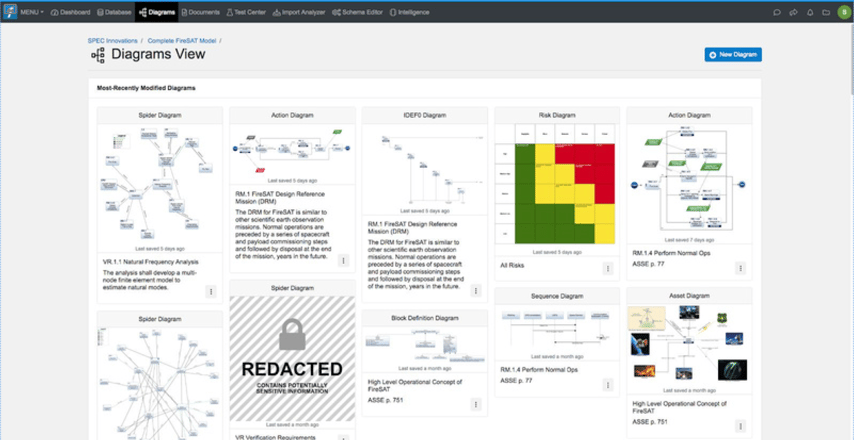
The modeling is done in one or many projects. Models between projects can be shared using the cross-project relationships available within the tool. Import/export of XML is also available.
Curation can be accomplished using Artifacts, Baselining documents, and export of models via XML (which can, in turn, be uploaded as Artifacts within the database). The information can be tagged using labels and searched for using the complex search capability.
Innoslate provides a means to author models in one language, such as SysML, and then display the information in other forms (e.g., LML, IDEF). The use of a common ontology (LML) that has been mapped to other languages (SysML) and Frameworks (DoDAF/DM2, IDEF0), enables this capability. Thus, information can be communicated in a form that any stakeholder can understand and assimilate.
Innoslate® was designed as a collaboration tool. All users of a project view the same database simultaneously. Real-time indicators display who is viewing what information, regardless of their perspective on that information. If an item is changed, a refresh indicator will appear. A built-in Chat (private and group) capability is also available to enable communications between users.
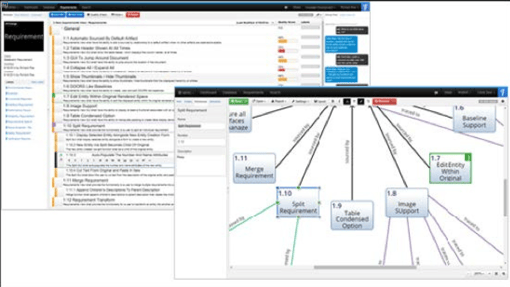
Innoslate's real-time indicators and chat enable collaboration around the world.
LML and Innoslate® support the entire lifecycle from concept development through disposal. It contains the capability to conduct program and test planning, CONOPS development, requirements analysis and management, modeling and simulation (discrete event and Monte Carlo), and verification through the Test Center. It also supports program management functions, such as Risk and Issue tracking, WBS development, capturing of decisions, and cost and schedule generation from business processes. Resource modeling and other constraints are also available via the tool. It has been used in every phase of the lifecycle.
Since the tool generates the diagrams and other views of the information from the database, it acts as a single source of “truth.” Since this database can be virtualized, it can grow as large as the hardware and SQL Server will allow. With cross-project relationships and permissions, we can also compartmentalize information as needed.
All artifacts (diagrams, reports, and exports) originate from a single database; therefore, all artifacts produced by the tool accurately represent the state of the information at the time of production.
Model-Based Reviews (MBRs) can be accomplished using the tool’s commenting feature (available at the object level and accessible from any diagram or view). MBRs have been performed using the tool for all the NASA milestone reviews. This capability was demonstrated to the NDIA M&S Committee in February 2014.
A Decision entity class is available within the tool to facilitate the decision-making process. However, all facets of the tool help inform decisions, particularly the Requirements Quality Checker and Intelligence Views, which utilize NLP technology to evaluate the quality of the modeling. The simulators also aid in verifying the processes.
Using a web interface makes the human-machine interface easier and more intuitive, plus it takes advantage of built-in browser tools, such as spelling and grammar checking. The underlying language (LML) provides explicit decision points that can be allocated to either the human or the machine, thereby making the modeling of these HAI processes clearer and more complete. The Java SDK and REST APIs also offer third parties the capability to design and experiment with different user interfaces. We refer to this as “Architecture to Operations,” a paper presented at the 2017 NDIA conference.
Innoslate® was designed for the application of new technologies and innovations for the digital enterprise. It Innoslate® was designed for the application of new technologies and innovations for the digital enterprise. It was one of the first systems engineering tools to use cloud computing and a web front-end. Currently, Innoslate® has applied Natural Language Processing (NLP) technology to check the quality of requirements, identify modeling issues (Intelligence View), and assist in the traceability of entities (Traceability Assist and Suspect Assist). With the use of the JavaScript interface, the simulator can use API calls to other web services and bring that information into the simulation. Additionally, the Java SDK and REST APIs facilitate the greater integration of new technologies into Innoslate by third parties.
Being cloud-based and compatible with all major commercial cloud environments (Amazon AWS, Google App Engine, and Microsoft Azure), as well as classified clouds such as NSERC and C2S, enables Innoslate to integrate seamlessly into modern IT infrastructures that will be used for digital engineering. Innoslate® was also designed with scalability in mind. Digital engineering will require the capturing and management of Exobytes of data. Scalability will become critical to that environment.
Innoslate® can support any methodology and be used to model processes and other aspects of those methodologies. Workflow can also be used to enforce processes.
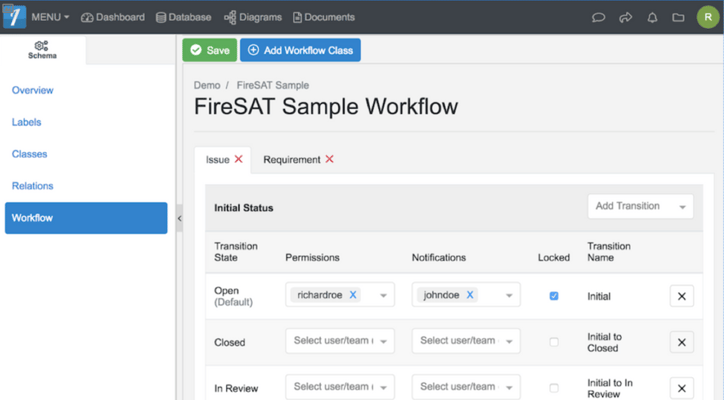
Innoslate's real-time indicators and chat enable collaboration around the world.
Innoslate currently utilizes best practices identified through work conducted at the Naval Postgraduate School and the Stevens Institute of Technology as the basis for the heuristics used in Intelligence View. Additional best practices can be captured as a document in the Documents View for sharing with other projects in the organization.

Intelligence View enforces best practices in digital engineering modeling.
Since Innoslate® automatically captures all change information, these History files can be mined to identify ways to improve digital engineering practices. The Activity Feed on the dashboard also allows managers to see who is changing what. Workflow provides a means to control changes in the status of requirements, issues, and other entity classes in the tool.
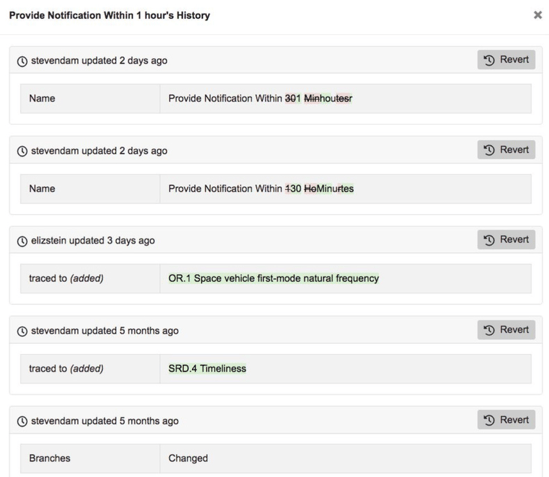
Innoslate tracks the change history of every entity
Figure 1. shows a SysML Internal Block Diagram (IBD) for the Innoslate modular architecture. Plugins are viewpoints of the Innoslate database. Plugin features include:
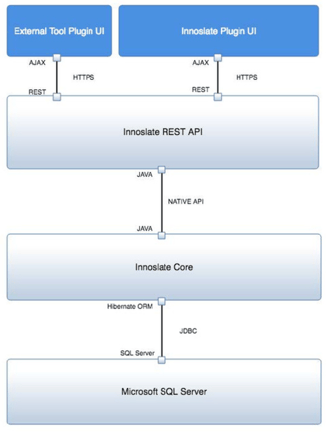
Innoslate Modularity
Innoslate provides various diagrams to visualize the system's components and interfaces, including the Asset Diagram (LML), Internal Block Diagram (SysML), and N2 Chart. All these diagrams utilize the same ontological elements: Assets for components and Conduits for interfaces. Data flows (Input/Output entities) can be allocated to the Conduits. These data flows have “size” (which can be a distribution), and the Conduits have “capacity” and “latency” attributes as well. These attributes are used in the simulators to constrain the functional model, thus affecting the overall system performance.
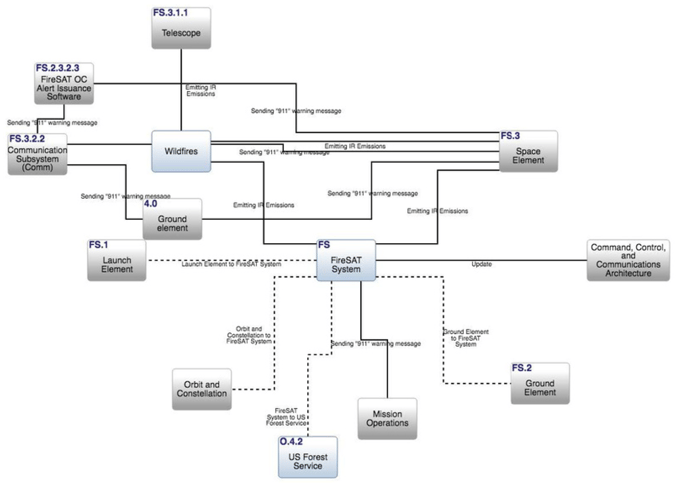
Innoslate's unique Physical I/O Diagram shows Assets, Conduits, and I/Os in one chart
In addition, Innoslate® provides a CAD Viewer to view .stl or .obj files, which are standard output formats from CAD tools. If the .obj file is used, the objects in the file can be translated into Innoslate Asset entities and linked back to the drawing.
The underlying language (LML) provides an ontology where all classes of information are decomposable. This capability enables modeling to be performed at any necessary level of detail. Innoslate also supports cross-project relationships, allowing each level to be modeled separately, if desired, and then shared with other models. This modularity will become critical when it comes to sharing proprietary information. Users who do not have permission to view information from a particular project will not be aware of that information if it is included in another project through cross-project relationships. A redaction bar shows up in its place.
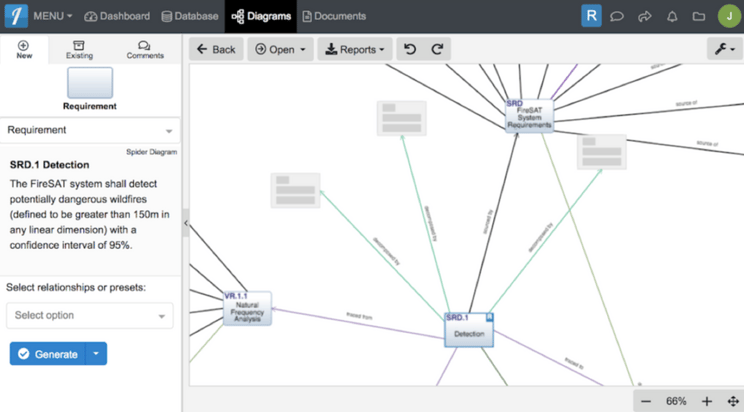
Innoslate permissions and cross-project relationships enable the use of information from other projects while protecting that information
This visualization occurs with any of the physical diagrams. Again, if cross-project relationships are used, you can see those specific interfaces. Another visualization tool is the Spider Diagram. Since Innoslate uses relationships to capture interfaces, the Spider Diagram also displays those related elements.
Since interoperability requires interfaces at multiple levels, Innoslate provides the means to identify these interfaces at every level. The fact that all the drawings are generated from the data will enable the analyst to see how the information is connected. Further research in this area is also feasible and may be another area where graph theory and NLP technologies can be applied to provide more automated heuristics.
Innoslate® provides the means to identify any interfaces between hardware and software as well. They are both (along with people) considered “Assets” in the ontology. Assets can have Conduits or Logical Connections between each other. So, if the modeler does not want to use the Conduit, they could use the Logical connection for this purpose. And, of course, other relationships can be provided using the Schema Editor.
Innoslate® comes with a complete set of APIs, including Java, REST, and, for Enterprise users, JavaScript. Innoslate developers also use these APIs, so they are rarely deprecated. We have developed completely new user interfaces for Innoslate® to mimic legacy tools using these APIs.
The APIs provide a means to “put” or “get” information and can provide this function. Other data transfer mechanisms for models include XML and XMI importers, as well as import capabilities for Word, CSV, and Plain Text.
Standards can be captured as Artifacts and decomposed into Statements and Requirements. Those standards can then be easily related to any other information in the database, including interfaces (Conduits) and components (Assets).
Innoslate® provides the Traceability Assistant as part of the Traceability Matrix. This matrix and assistant can be used in conjunction with the standards to trace interfaces and components, helping to identify whether the standards are being met.
In addition, when rules are available, Innoslate diagrams, such as the IDEF0, have the tools to indicate when errors occur. For example, when the number of boxes exceeds six on the diagram, this violates one of the IDEF0 rules (must have between 3 and 6 functions on a graph).
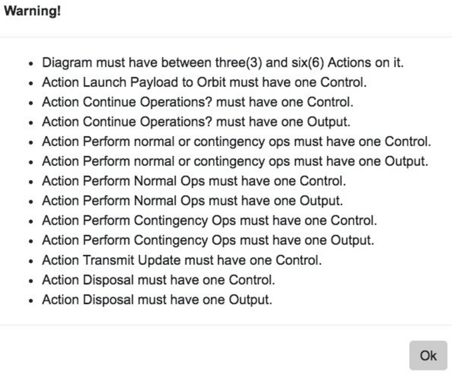
Innoslate rule checking aids the modeler in meeting requirements
Intelligence View checks the entire model for best practices, utilizing 68 tailorable heuristics developed by the US Naval Postgraduate School.
These criteria can be captured as part of the Test Center’s Test Cases and results. If criteria can be developed for these, SPEC would be interested in using those criteria as part of its Intelligence View, as well.
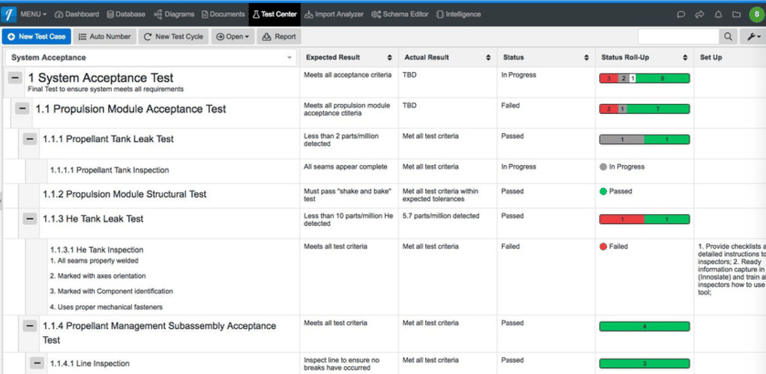
Innoslate software is an authoritative source of truth for your digital engineering ecosystem. See digital engineering in action. Schedule a demo with an expert today.
Have questions about model-based systems engineering or requirements management? Talk to an expert and see how Innoslate can streamline your projects from start to finish.

Not up for the read? Sit back, relax, and watch the webinar recording! Organizations today are increasingly recognizing the need for digital...

2 min read
The United States Air Force (USAF) has long been at the forefront of technological innovation, and its adoption of digital materiel management...
.png)
1 min read
Innoslate® provides a very secure platform for capturing, analyzing, and reporting your systems engineering and program management information. We...